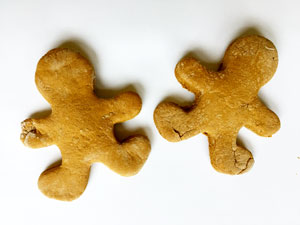I love holiday food. A current favorite is “Soft and Chewy Ginger Molasses Cookies” from Table for Two. My kids call them gingerbread cookies and love them. Just like the name says, these cookies are soft and chewy with a great blend of spices. A very different cookie from the hard gingerbread cookies used to make gingerbread houses.
My kids recently got to experience hard gingerbread at a historical holiday reenactment*. These cookies were made following a recipe from 1845 and baked in a brick oven. They were hard and tasted strongly of ginger. Clearly, gingerbread has evolved.
This got me thinking. How are the cookies different? How are they the same? We made both recipes at home and here is what we found.
The 1845 Gingerbread Cookies
Gingerbread has been around since the Middle Ages. Each region that made gingerbread had their own spin on it, so this recipe from The New England Economical Housekeeper (a recipe book published in 1845) is by no means the original gingerbread cookie recipe. But it is still an old recipe and highlights how much desserts have evolved.
The first thing I noticed when I read the recipe was its short ingredient list. Seriously, it takes five ingredients to make these cookies and one of those ingredients is water. This drives home the fact that supplies were more scarce back then. People did not always have eggs or sugar in their pantry and running to the store was not always an option.
Unlike modern recipes, this one said to add the baking soda early on. Every time we added a new ingredient the mixture fizzed a little with carbon dioxide bubbles.
The second odd thing about this recipe was the lack of oven temperature. Back in 1845 they used brick ovens. At the historical reenactment the baker had to build a fire inside the oven, let it heat for over an hour, then take out the fire to make room for the cookies. She said that baking was really tricky. If the fire was hotter on one side of the oven the cookies would bake unevenly. Sometimes the oven took a really long time to warm and there was no way to guarantee the oven temperature. Watching her work made me really grateful for my electric oven with a thermostat.


The recipe said to bake five minutes. I set the oven to 350F and it took about 15 minutes for the cookies to bake. The fresh cookies weren’t too bad. They were crunchy, and more spicy than sweet. By the next day, the cookies were rock hard. They were perfect for our gingerbread house.
The Modern Gingerbread Cookies
I am partial to soft cookies. This recipe from Table for Two fits the bill perfectly. It is so soft that it doesn’t work great for cut out cookies unless you add more flour, but the taste makes up for the lack of fun shapes. Following this recipe was not hard because it is a modern recipe. I had all the right equipment and the methods were similar to other cookie recipes I’ve used. But after making the historical recipe, certain things caught my attention.
First off, there are so many ingredients. It has two types of sweeteners and four different seasonings. In this recipe, molasses is used more for its flavor than its sweetness. The other spices help to round out the pungent ginger flavor. All of these “extra” ingredients are in my pantry and I take their presence for granted.
| Old Recipe | New Recipe | |
|---|---|---|
| Molasses | 3/4 cup | 1/4 cup |
| Sugar | 1 cup | |
| Water, Boiling | 1/3 cup | |
| Butter | 3/4 cup | |
| Eggs | 1 | |
| Flour | 2 1/4 cups | 2 cups |
| Baking Soda | 1 tsp | 2 tsp |
| Salt | 1/2 tsp | |
| Ginger | 1 tsp | 1/2 tsp |
| Cinnamon | 1 tsp | |
| Ground Cloves | 1/2 tsp |
Secondly, the ratio of soft, or wet, ingredients (sugars, eggs, butter) to dry ingredients is very different between the two recipes. The chart above shows the differences in ingredients. Notice how the old recipe has slightly more than 1 cup of soft ingredients to over 2 cups of dry ingredients, whereas the new recipe has about 2.5 cups of soft to 2 cups of dry.
A Close Up Look
I played around with my camera and got a couple close up photos of the insides of the cookies. Notice how dry the hard gingerbread cookie looks compared to the soft gingerbread cookie. Also, the textures are very different. The dough of the hard cookie was strong enough to expand with the creation of individual bubbles during baking and hold that shape. As a result, it has lots of little air pockets. The soft cookie’s dough was not strong enough to do that so it has fewer and bigger air pockets.
Wrap Up
Our perception of what is a dessert has changed over the years. When gingerbread cookies were first introduced they were popular because of their unique flavor. But the gingerbread cookies from the past are terribly bland comparied to modern cookies. Our modern cookies would not be possible without easy access to ingredients that were scarce, expensive, or not available at all in the past.
*The historical baking was a part of “A Carillon Christmas” at Carillon Historical Park.







